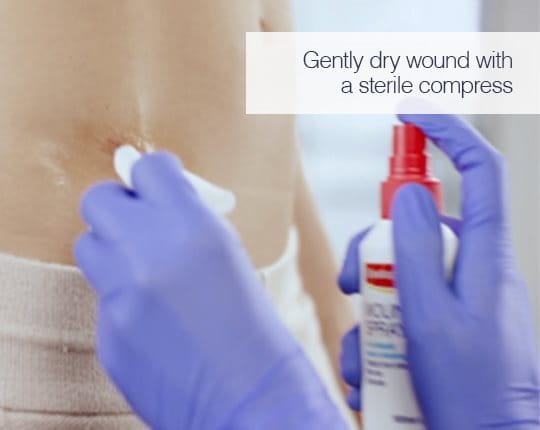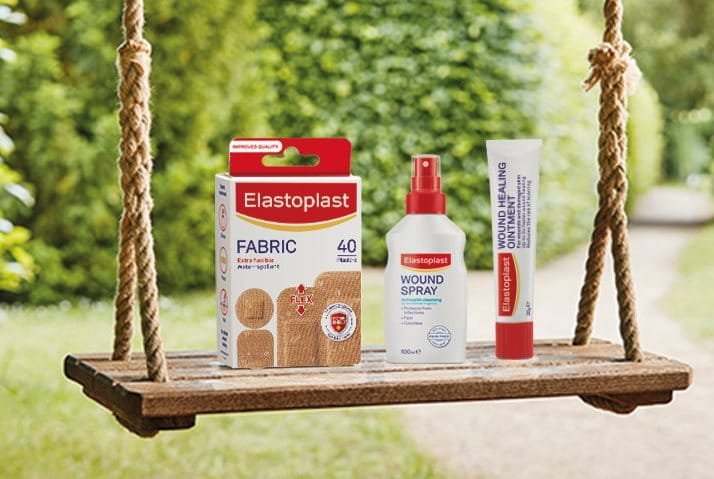What are surgical wounds?

Post-operative wounds, also known as surgical wounds, are carried out by medical professionals who perform these surgeries with precision and great care, under sterile conditions.
They are characterised by regular sharp, clean wound edges and often closed with sutures, glue or staples. In these cases, so-called dry wound care is recommended i.e. covering the wound with a dressing without providing moist wound healing conditions.
An appropriate dressing for post-op wounds should therefore:
- be sterile
- provide a good barrier, absorb fluid or exudate and keep the wound dry
- be adherent to the skin but atraumatic on removal and not stick to the wound
- cause minimal tissue injury when removed
The surgical wound dressing and wound pad size should always be chosen to suit the wound size, to ensure that the wound area is completely and safely covered by the wound pad.
As an alternative, a sterile compress can be used combined with an unsterile fixation such as the Elastoplast Fabric Roll Plaster depending on wound location and individual preferences.
How to care for surgical wounds

Post-operative wound care is always related to the individual wound situation, treatment as per doctor's recommendation. When treating a post-operative wound make sure to wash your hands thoroughly, put on gloves to prevent infections and use sterile dressings.
Elastoplast Sensitive Dressings
- are sterile
- are dermatologically approved*
- have highly absorbent, non-sticky wound pads
- protect from infection
- can be used for cuts, abrasions & post-operative wounds
*skin compatibility dermatologically approved
The dressing should be changed regularly, as per doctor’s recommendation. This also gives you the chance to observe the wound regularly to detect complications early.
Why is wound care after surgery important?
Wound care after surgery is important to ensure proper wound care for post-operative wounds. This is essential to:
- prevent infections
- reduce scarring
- minimise pain during dressing changes
- provide easy, convenient, and safe wound treatment for undisturbed healing without complications.
After surgery has concluded safely, the first surgical wound dressing is applied usually in the operation theatre. Typically, sterile surgical wound dressings are used.
The patient will be given information on basic hygiene rules such as how to change the dressing, ensuring it's done under antiseptic/hygienic conditions to protect from water, dressing a wound and checking the wound regularly to detect complications early.
Keeping the wound clean after surgery
Keeping the wound clean after surgery can be done by cleaning the skin around the cut with a soft cloth or gauze pad. This will ensure that the skin around the wound is clean and limits the chance of infection, while also ensuring that the surgical wound dressing is not damaged by water.
Firstly, the cloth or gauze should be soaked in soapy water or sterile water mixed with salt. The skin around the wound should then be wiped or dabbed gently.
It is important to only use sterile salt water or soapy water and not liquids like alcohol, iodine or antibacterial soaps as this can aggravate the wound.
Taking care of stitches after surgery
Stitches can be applied to the wound and may be dissolvable (meaning they will disappear in a few weeks) or non-dissolvable (meaning they will need to be removed by a nurse or doctor). This may be up to 14 days after the operation.
After this has been completed, a surgical wound dressing will be applied to the wound, and this will need to be changed every 24-48 hours. Learn more about stitches here.
Keeping the wound clean & dry
Typically, you are advised to wait 48 hours before showering after an operation to prevent the surgical wound from being wet and delay healing, although this will depend on the operation you have had.
Waterproof dressings for surgical wounds are great to use after the first few days of using a regular wound dressing, and the Elastoplast Sterile Waterproof XL dressing provides protection against infection and contamination.
In any case, the nurse/doctor will provide advice and information about how to prevent the wound from being wet and keeping it dry when showering or washing the body after your operation.
Some tips to do this are:
• Do not apply soap, shower gel, talcum powder or other bathing products directly onto the wound, as this will delay healing
• Showering is preferable to bathing.
• Pat the wound gently with a clean towel after showering.
• Do not rub the wound area as this can aggravate the wound and cause pain
How long to keep a dressing on after surgery
Surgical wound care is always related to the individual wound situation and the treatment should be performed as per the doctor's recommendation.
After the primary wound closure by the surgeon the wound is generally protected with a sterile dressing. Approximately after 2 days* the dressing is changed for the first time and the wound observed by the doctor. Afterwards, the dressing should be changed daily (individually after consultation with the doctor). This can be done at home by the patient.
Always make sure to:
- use sterile wound dressings
- follow basic hygiene rules
- change the dressing under antiseptic / hygienic conditions (non-touch technique, protect from water)
- observed the wound regularly to detect complications early.
How long do surgical wounds take to heal?
In general, after 6-12 days* after surgery the sutures, staples or drains are removed by the doctor. Proper care according to the doctor’s recommendation is important until the post-operative wound has healed completely.
The healing time depends on its size and location. Underlying illnesses like diabetes as well as age can also influence the healing process, with older patients’ wounds sometimes requiring more time.
*individually different, decision by the attending physician
Surgical wound infection
While it can be difficult to create a sterile environment at home, surgical wounds should be treated with sterile dressings to reduce the risk of wound infections. Dressing the wound in a hygienic way is important: wash your hands before treatment, wear gloves and don’t touch the wound pad while opening or applying the dressing (this is called a non-touch technique).
As with any type of wound, it is important to keep an eye on healing progress and watch for signs of wound infection after surgery. Contact your doctor immediately if you experience excessive redness or swelling around the wound or sutures, unpleasant smell or discharge, or if you feel warmth.
While you may experience some post-operative pain following a procedure, these symptoms or additional pain could indicate an infection. Use Elastoplast XL Sensitive Plasters to seal the wound, prevent contamination and cushion the skin without sticking to it.
How to reduce the risk of scarring after wound closure

To reduce the potential scarring for smaller surgical wounds, apply Elastoplast Wound Healing Ointment before dressing your surgical wound. This helps create a moist healing environment to help speed up the natural healing process.
Once your surgical wound has healed, Elastoplast's Scar Reducer XL patches can help reduce the visibility of raised and red scars, with the first results visible after 3-4 weeks. These transparent patches are designed to build a semi-occlusive barrier which improves hydration of the scar tissue. Learn more about how to treat and prevent scars.
The Do’s and Don’ts to heal surgical wounds








